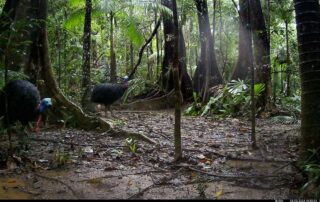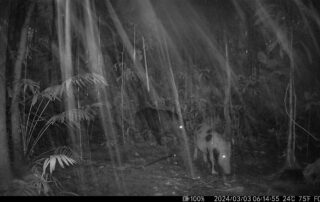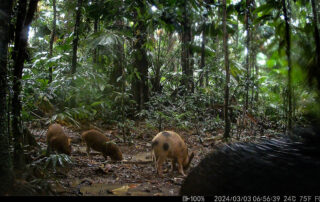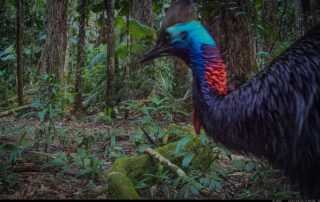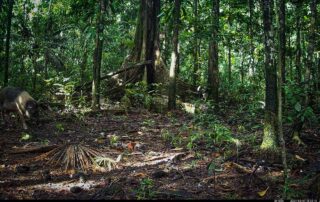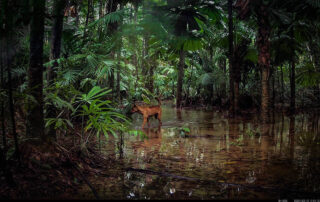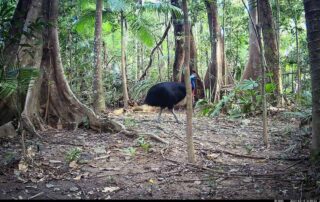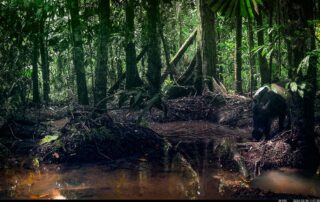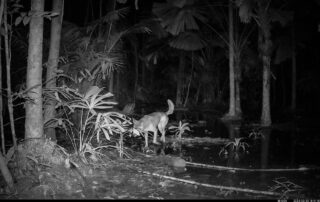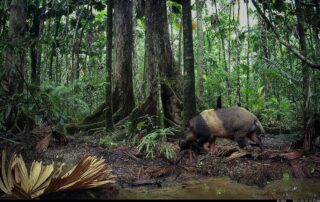Camera Traps – March 2024 accrued 37-cassowary sightings, 17-dingoes and 174-feral pigs. Against the cumulative monthly average, cassowary numbers fell by 66%, dingoes also decreased by 57%, but feral-pig numbers grew by 10%. Against March 2023, cassowaries were 64% fewer, dingo numbers plummeted by 86% and feral-pigs also dropped by 25%.
Image highlights from March 2024
Giant White-tailed Rat – Uromys caudimaculatus
Over the years of this camera trap’s study, camera # 5 has captured the most tree kangaroo sightings, with a couple of video-clips of a male in enthusiastic pursuit of a female across the forest floor. It is highly likely that this aspect of Bennett’s Tree Kangaroo reproductive behaviour is carried out on the forest floor to avoid the danger of falling from great height from the treetops above and since more of this action has been captured on this particular camera, suggests that the giant Yellow Penda at the centre of the camera’s field of view could well be the home tree for the male.
Surmising as much in the presentation of the 4-hour Greater Wilderness Experience, in early October last year a Canadian traveller returned a couple of weeks after his tour and offered his expertise as an arborist to establish a camera trap in the enormous tree’s crown. I have since cleared this camera of data and found thousands of files of leaves and branches moving, but alas, no tree-kangaroo. Perhaps unsurprisingly, the limbs of large trees move quite considerably in the wind but particularly in relation to other branches upon the same tree. As each movement takes a photograph and generates video lasting 10-seconds, every month produces hundreds of images and video-clips and studying each one for a possible tree-kangaroo sighting is tedious and prone to slumber. However, on the 12th March 2024, a Giant White-tailed Rat was filmed and even though it is less exciting than the elusive Bennett’s Tree Kangaroo, it is far more gratifying than windy movement of leaves.
The battle for Daintree Rainforest custodianship
25-years-ago, a group of Daintree Rainforest landholders presented the Queensland Cabinet with a draft DAINTREE COAST COMMUNITY PROTECTION AND MANAGEMENT ACT 1999, to provide for the protection and management of 1,136-private properties covering 7,836-hectares or about 8% of the greater Daintree Rainforest between the Daintree River and Cape Tribulation and for the related purposes of coordinated tourism management and community prosperity. Disappointingly, this generous expression of community-driven initiative was as resoundingly rejected by the Cabinet, as it was disregarded by the media.
At around the same time, a group of activists with Local Government support, who for years had been touting travellers at the Daintree ferry for donations to ‘Save the Daintree Rainforest from residential development, transferred their collection of acquired properties to the newly established environmental foundation, Rainforest Rescue from Byron Bay in NSW. A quarter-century later, Rainforest Rescue had accrued 44-Daintree Rainforest properties, covering 122-hectares (less than 1.6% of the privately-held portion of the area), three-quarters of which they describe as ‘Protected Forever’. 83-freehold-properties had also been acquired over the four preceding years, under the intergovernmental Daintree Rescue Package, three-quarters of which was cleared land.
Without any doubt, the greatest contributor to saving the Daintree Rainforest, by far, is the community of landholders that invested their personal wealth into ownership, occupancy and residential custodianship. If the purchase price of 1,136 properties covering 7,836-hectares averaged out at a very conservative $100,000, $113.6-million would have been invested into acquisition, on top of the annual rates payments, which for years were 234% higher than large residential properties south of the Daintree River (but with comparatively none of the services).
When outside agencies and foundations purchase Daintree Rainforest property, it is not with the passion and conviction of the purchaser’s personal wealth, but with other peoples’ money, whilst the ongoing costs of property management are increasingly deflected onto either the taxpayer or Traditional Owner interests upon lands that have extinguished Native Title, but with custodianship robbed of residential vigilance, cost-effectiveness and defence from squatters and feral pests; not even remotely approaching ‘protected forever’. These comparative failings also rob the custodial community of environmental assets, including the integrity of community boundaries and legal entitlements to exclude trespass. Tremendous tourism advantages of holding a monopoly of access to rainforest along the road networks was fragmented by the usurpation of public-ownership and publicly-funded visitor facilities onto freehold properties, to then be re-gazetted as National Park. The rate-base of the Local Government is also eroded and properties are made vulnerable with absentee landlords, exploited for unauthorised commercialisation that by-passes planning ordinances and excised from the authority of the conservation community. Nevertheless, these compromising weaknesses did not stop local media from highlighting the aforementioned Rainforest Rescue for celebrating 25-years of restoring and conserving the mighty Daintree Rainforest.
Australia’s Intergovernmental Agreement on the Environmental 1992 stipulates that environmental goals, having been established, should be pursued in the most cost effective way, by establishing incentive structures, including market mechanisms, which enable those best placed to maximise benefits and/or minimise costs to develop their own solutions and responses to environmental problems. Environmental protection of rainforest within the settlement areas between the Daintree River and Cape Tribulation, should accordingly be the core business of the residential community, to maximise the benefits and minimise the costs of custodianship of its primary income-earning asset.
Rather than undermining and eroding community custodianship through covetous usurpation, environmental charities from far and wide should re-direct their fund-raising successes into supporting the Daintree Rainforest community achieve world-inspiring custodial excellence and media should acknowledge and honour the custodial community for its unrivalled and unstinting commitment to Daintree Rainforest conservation excellence.
Daintree Rainforest Foundation Ltd has been registered by the Australian Charities and Not-for-profits Commission and successfully entered onto the Register of Environmental Organisations. Donations made to the Daintree Rainforest Fund support the Daintree Rainforest community custodianship and are eligible for a tax deduction under the Income Tax Assessment Act 1997.


